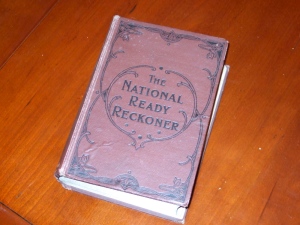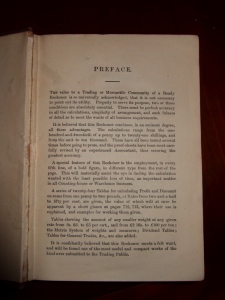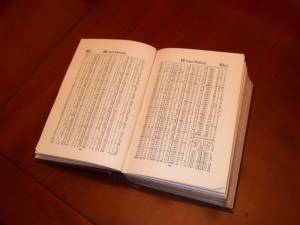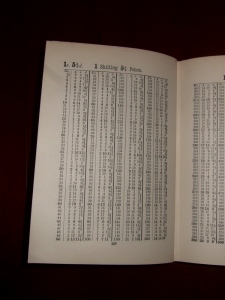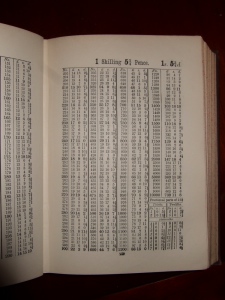Here’s some very old tech, which I found in a second-hand bookshop.
Almost every currency in the world is decimal. The only two non-decimal currencies left are the Madagascan ariary, which is subdivided into 5 iraimbilanja, and the Mauritanian ouguiya, which is subdivided into 5 khoums. American money went decimal as far back as 1792; before that, the official currency had been the British pound, but besides the awkwardness of the LSD units, British coinage was hard to get hold of anyway. Business was done using whatever currency was to hand, including shells and tobacco.
The UK and Ireland didn’t move over to decimalisation until 1971. Until then the British pound was divided into 20 shillings, each of which was itself subdivided into 12 pennies. Up to 1960, it was even more awkward, because each penny was further subdivided into 4 farthings. So all this is recent enough to still be within living memory, but not recent enough for electronic calculators, never mind personal computers. So how did normal mortals manage to perform the financial calculations necessary for either day-to-day living or – gulp – running a business? If someone came into your shop and bought 9 items that each cost, let’s say, 7 shillings and 11 pence each, how did you work out what change to give then from ten pound note?
There were three ways. Firstly, you could do the calculations by hand. People actually became pretty adept at this, and were remarkably good at doing complicated sums in their head, but in general, as you might expect, this method was slow and somewhat error prone.
The second way was to use a mechanical adding machine. These included devices such as the pin-wheel machine or the comptometer. However, these machines were expensive and required special training to use them.
The third way was to use a non-mechanical aid. You might already know about slide rules and log tables, which were quick to use but not very accurate (maybe 4 decimal places), and in any case weren’t good at dealing with non-decimal numbers. You had to convert your calculation to the decimal form, then do the calculation and then convert back.
The most popular solution was the Ready Reckoner.
Basically, it’s 851 pages of tables.
Each pair of pages is for one monetary value – 19 shillings and 9 pence, say, or 2 shillings four pence ha’penny – and contains all the multiples for that amount, going up to 10,000 in steps of varying size. So if you wanted to know what 187 lots of 1 shilling, 5¾ pence added up to, you simply turned to the page for 1s. 5¾d. and read off the value for 187. The book tells me it’s 13 pounds, 16 shillings and 7¼ pence, and it took me about 5 seconds to do it.
Several manufacturers published Ready Reckoners. This particular volume is entitled “The National Ready Reckoner”, and was published by Collins; from research, I think this might be the 1904 edition, but there’s no publication date in the book itself.
The ready reckoner had a number of advantages over the other solutions. It was much cheaper, for one thing. It couldn’t break. It didn’t need an expert to operate it. It was actually faster to use than the mechanical adding machine, and it handled non-decimals “natively”. Of course, it couldn’t do anything else. All this was in the days before software: most aids couldn’t be repurposed to do anything else. For British currency, the Ready Reckoner was the best solution, but if you wanted to do calculations on the US dollar, or the Mauritanian ouguiya, or if you wanted to do multiply up some imperial weights, you were stuck.
